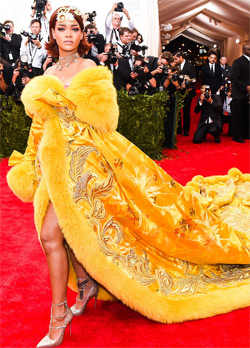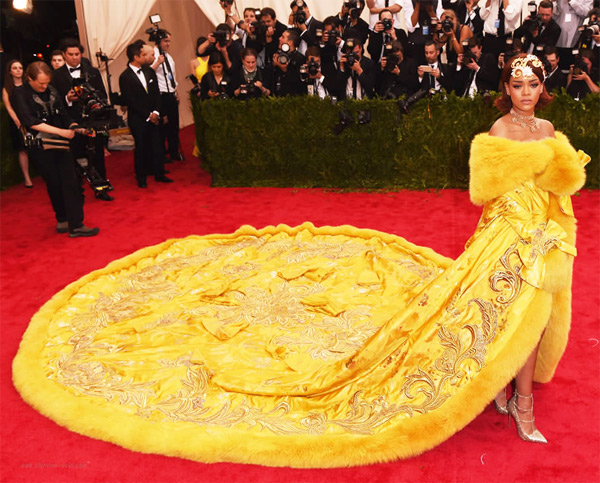 Rihanna at Met Gala wore fur-trimmed yellow satin gown and stole all the limelight. It was designed by the Chinese-born designer Guo Pei . The fashion world pretty much came to a standstill, Glamour magazine wrote of the jaw-dropping cloak, while Time magazine declared that the singer stole the show.
Rihanna at Met Gala wore fur-trimmed yellow satin gown and stole all the limelight. It was designed by the Chinese-born designer Guo Pei . The fashion world pretty much came to a standstill, Glamour magazine wrote of the jaw-dropping cloak, while Time magazine declared that the singer stole the show.
Yet Ms. Pei isnt the first Chinese-born designer to create a media meltdown with a spectacular design. The X-Men star Fan Bingbing wore a bright yellow dragon dress by Laurence Xu to the 2010 Cannes Film Festival, and The Hollywood Reporter wrote that it launched her into the style stratosphere. Sensational! the website Red Carpet Awards proclaimed.
The dress got so much attention, in fact, that the actress Qin Hailu complained publicly that Ms. Fan was using the dress to cast herself as Chinas leading lady (a charge that Ms. Fan denied), and Londons Victoria & Albert Museum ultimately snapped it up for its permanent collection. Now, that dress and two Guo Pei designs are part of the Metropolitan Museum of Arts new Costume Institute exhibition, China: Through the Looking Glass.
Juxtaposed against a dragon dress made by Tom Ford for Yves Saint Laurent, Mr. Xus gown highlights the different ways contemporary Chinese designers interpret their aesthetic history, and reflects the approach of a new wave of Asian creators who are drawing attention and acclaim for work that is defined by a modern balance between East and West.
Last year, for example, Yiqing Yin, the Chinese-born, Paris-based couturier who won the fashion designer of the year award at Frances prestigious Globes de Cristal in April, was named artistic director of the French fashion house Léonard. And in 2008, Qiu Hao won the International Woolmark Prize, thanks to the hand-woven fabrics he uses in his minimalist, architectural looks.
With so many brands doing so many different things, and a country of 1.3 billion people, the Chinese designers dont have to adapt to us in the West, and well see this develop, said Gemma A. Williams, the author of Fashion China. They will learn from what weve done and put their own spin on it.
Witness Boundless, designed by Zhang Da, which gives classic padded, quilted agricultural coats a new spin by reimagining them in luxury cottons, soft pinks and modern geometrics. Or Chictopia, designed by Christine Lau, whose pop prints are drawn by hand rather than computer. Dooling Jiang of Digest Design also uses a traditional approach, in her case ancient cutting techniques, to create conceptual pieces like a landscape-inspired shirt-and-cropped-trouser combo; minimalist, wrapped jackets; or crinoline-esque paper-thin dresses.
As the Qingdao-born, London-based designer Huishan Zhang said, theres more to Chinese design than dragons, phoenixes and the color red.There is a really interesting feeling of these designers working with a blank slate, and much more willing to take risks with their designs, Angelica Cheung, the editor in chief of Vogue China, wrote in an email. When the magazine started, in 2005, she struggled to find local designers to fill her pages, but is now, according to her, completely overwhelmed.
The 32-year-old Ban Xiaoxue, for example, is one of Chinas rising stars; he won the Asian final of the 2012 International Woolmark Prize the same year he introduced his namesake label. Based in Guangzhou, he uses ancient embroidery techniques to create modern floral and grid patterns on signature floating, feminine pieces, and is known for his fabric experimentation.
Then there is the philosophical approach of Evening, designed by the Beijing-based Yu Wanning, whose last collection, full of sculpted wool jackets with fur sleeves, cropped chunky knits, and long sheer skirts, was inspired by wu qin xi, a traditional form of exercise that uses the movement of animals to balance the body and mind. Not to mention the mix of classic Mandarin collars on sheer embroidered tops with cutout shoulders by Liu Min, 34, who trained at Viktor & Rolf; she also designs organza sweatshirts traced by rubber calligraphy.
Chinese street-style stars like Leaf Greener, a stylist, blogger and former senior fashion editor of Elle China, are helping bring these Chinese designers to a broader audience, whether on Facebook and Instagram or on Chinese microblogging sites like Weibo and WeChat.
I mix and match, Ms. Greener said. At Giambattista Vallis show in Paris this season, I wore a simple turtleneck sweater by new Chinese designer Chrisou by Dan with Calvin Klein skinny jeans, Céline coat and brown Louis Vuitton patterned ankle boots. It showed that Chinese fashion is not about the past but its about whats happening right now.
Christopher Bu, a former stylist who became a designer in 2010, attributes the fast success of his label to Weibo feeds that have showcased celebrities in his clothes, like Xu Fan and Fan Bingbing, who modeled his gold gown and geometric cape at the Met.

Similarly, Qiaoran Huang and Josh Hupper, whose hip street wear label, Babyghost, has been shown at New York Fashion Week for the last two seasons (they split their time between Manhattan and Shanghai), are using social media as a conduit for their brand.
Weve developed a sixth sense for customer reaction because of the immediacy of Qiaorans blog and Instagram, Mr. Hupper said. We are using the reaction to our products on Instagram to come up with product numbers so we are building a fan-based business.
For Andrew Bolton, the curator of the Costume Institute show, this is a reflection of the future. As the Chinese designers are so sophisticated in technology, and the future of fashion is technology, Chinese designers are well placed to take advantage of this, opening up the market and the parameters of fashion, he said.
Or, as Ms. Pei, who created the 280 handmade theatrical designs for the 2008 Beijing Olympics opening ceremony, said via Skype from her cavernous Rose Studio in Beijing, Everyone wants to learn about China, and fashion is the easiest way.
China: Through the Looking Glass is at the Costume Institute at the Metropolitan Museum of Art through Aug. 16. Robyn Rihanna Fenty known mononymously as Rihanna, is a Barbadian recording artist, actress and fashion designer. Born in Saint Michael, Barbados, she began her career as a result of meeting record producer Evan Rogers in late 2003. At age 16, she moved to the United States to pursue a music career and began recording demo tapes under Rogers’ guidance, subsequently signing a contract with Def Jam Recordings after auditioning for American rapper Jay-Z.
Rihanna’s debut studio album, Music of the Sun, peaked at number ten on the Billboard 200 chart and features the Billboard Hot 100 top three hit single “Pon de Replay”. Her second album, A Girl Like Me , peaked at number five in the United States, and produced her first Hot 100 number one single, “SOS”. Rihanna’s third album, Good Girl Gone Bad ,spawned the international hit singles “Umbrella”, “Don’t Stop the Music”, “Take a Bow”, and “Disturbia”. The album was nominated for nine Grammy Awards, winning Best Rap/Sung Collaboration for “Umbrella”. Her fourth album, Rated R , produced the top ten singles “Russian Roulette” and “Hard”, plus the number one hit “Rude Boy”. Rihanna’s fifth album, Loud , spawned the number one hit singles “Only Girl (In the World)”.
“What’s My Name?”, and “S&M”. Her sixth album, Talk That Talk , served the worldwide chart topper “We Found Love” and the top five single “Where Have You Been”. Rihanna’s seventh album, Unapologetic , became her first number one album on the Billboard 200 and generated her twelfth Hot 100 number one single “Diamonds” and the top five hit “Stay”. In addition to her solo music, Rihanna has collaborated with numerous other artists, notably being featured on the worldwide hits “Live Your Life” (with T.I.) and “Love the Way You Lie” (with Eminem).
Rihanna’s work has earned her numerous awards and accolades, including seven Grammy Awards, five American Music Awards, eighteen Billboard Music Awards and two BRIT Awards. Since the beginning of her career in 2005, Rihanna has sold 30 million albums and 120 million singles worldwide, which makes her one of the best-selling artists of all time.
She has achieved a total of twelve number one singles on the Billboard Hot 100 chart, becoming the youngest solo artist to achieve the feat. Billboard named Rihanna the Digital Songs Artist of the 2000s decade, and ranked her as the seventeenth overall artist of the same decade. In 2012, Forbes ranked her as the fourth most powerful celebrity of 2012 with earnings of $53 million between May 2011 and May 2012. The same year, American magazine Time named Rihanna one of the most influential people in the world.
Hopefully the Roar singer didn’t mind her Bajan BFF’s tardiness who tweeted a picture montage the following day. Rihanna wrote: ‘Happy Birthday to my lover and friend !! I miss you so much!! I love the phuck outta you!! I hope I could squeeze on you soon!! #KatyAnna @katyperry’. The Diamonds singer clearly had so much love for Katy, but she may well not have read the comments made by Perry about the risqué behaviour of some of her female contemporaries.
In a radio interview with NPR host Scott Simon on her birthday, Katy said: Everybodys getting naked. I mean, Ive been naked before but I dont feel like I have to always get naked to be noticed. Im not talking about anyone in particular, she said. I’m talking about all of them. I mean, it’s like everybody’s so naked. It’s like put it away. We know you’ve got it. I got it too. I’ve taken it off for – I’ve taken it out here and there. And I’m not necessarily judging.
‘I’m just saying sometimes it’s nice to play that card but also it’s nice to play other cards.’ Rihanna is known for filling her Instagram feed with a host of provocative photos, as is Miley Cyrus and Nicki Minaj. And recently, there has been a surge of female celebrities sharing pictures of their rears – a ‘belfie’ as it were – after Kim Kardashian shared her first post-baby swimwear shot where the focus was on her round derriere. Since then Kelly Brook, Lady Gaga and Cheryl Cole have tweeted images of their behind.